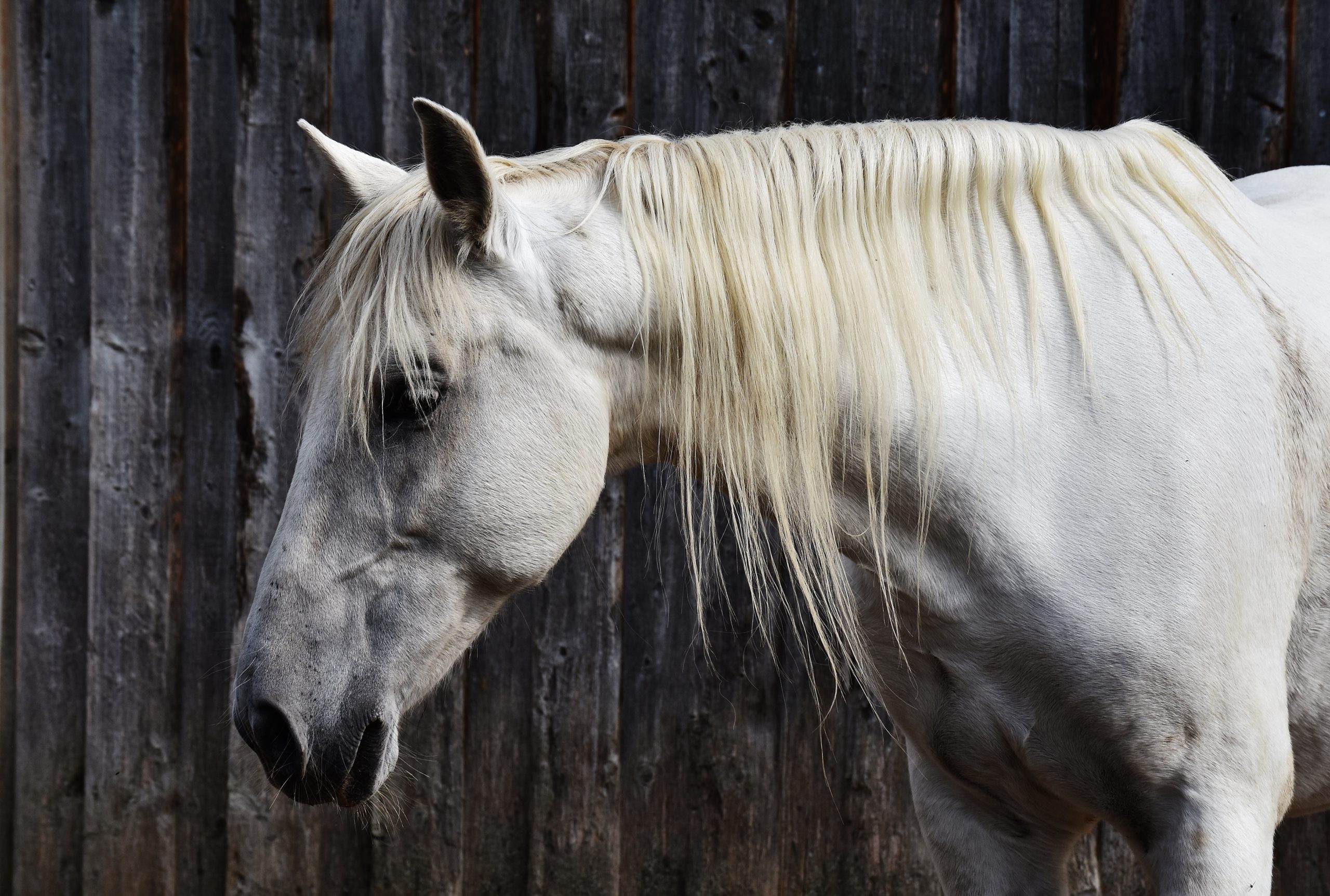Tying-up is a generic term commonly used to describe muscle disease in performance horses. Other terms often used interchangeably with tying-up include exertional rhabdomyolysis, azoturia, and Monday morning disease.
Horses experiencing a bout of tying-up show signs of a stiff gait, reluctance to move, firm painful cramping muscles, profuse sweating, increased heart rate and increased respiratory rate.
In addition to clinical signs, horses that tie-up will have moderate to marked elevations in serum levels of muscle enzymes, including creatine kinase (CK), lactate dehydrogenase (LDH), and aspartate aminotransferase (AST). Elevation in muscle enzymes indicates muscle cell damage and is considered a diagnostic tool to detect tying-up.
Classification of tying-up
For years, all horses that tied-up following exercise were thought to suffer from the same disease. However, treatment and prevention protocols that seemed to work on some horses did not help other horses. As a result, confusion and controversy developed regarding the cause and treatment of tying-up. Researchers have only recently begun to classify and study the many different disease conditions that result in the common symptoms of tying-up.
Initial classification of tying-up is now based on frequency of the disease symptoms following exercise. Horses that tie-up only a few times in their lifetime are classified as ‘sporadic’, while those horses that tie-up on a repeated basis are termed ‘chronic’.
The following is a brief discussion of both sporadic and chronic tying-up and steps that can be implemented to prevent future episodes of the disease. Much of the research into understanding tying-up and treatment/prevention protocols has been performed at the of the College of Veterinary Medicine at the University of Minnesota.
Sporadic Tying-Up
Many horses experience some muscle strain and soreness associated with exercise. These horses often are mistakenly thought to be suffering from muscle disease. Inadequate warm-up, pre-existing lameness, exercise to the point of fatigue, and insufficient training can result in muscle soreness and injury. A similar human scenario might be overexertion from strenuous physical activity in a person conditioned to sit behind a desk.
In horses that actually tie-up, muscle soreness is much more severe and is typically accompanied with elevated serum muscle enzymes and myoglobinuria (coffee-colored urine). This darkening of the urine is a result of the kidneys filtering myoglobin (a muscle protein) from blood, an indication of severe muscle damage. The most frequent causes of sporadic tying-up are exercise that exceeds a horse’s underlying state of fitness, electrolyte depletion, hyperthermia, and strenuous exercise while suffering from a respiratory disease.
Sporadic tying-up usually involves a specific muscle group and should be considered a veterinary emergency if horses are sweating profusely, reluctant to move or have dark urine. Veterinarians may administer treatment to relieve anxiety and muscle pain. In addition, fluids and electrolytes are often given to account for fluid losses and myoglobinuria that may damage kidney function.
Further treatment strategies include stall rest followed by hand walking and turnout once initial muscle stiffness is gone. Grain intake is drastically reduced or eliminated since these horses are likely to be on a reduced exercise program, and may need to be reduced once the horse resumes full work.
The amount of time the horse must remain out of training has not been firmly established by science, but monitoring of serum muscle enzyme levels may be useful. However, any training regime following an episode of tying-up should be resumed gradually and consistently to prevent further muscle damage.
Prevention of further tying-up episodes is often a result of common sense. Learning not to overexert unfit horses and remembering to fortify the diet with salt on a daily basis as well as electrolytes prior to heavy sweat loss are logical strategies. Horses with lameness or upper respiratory tract infections have an increased risk of tying up. Adjusting the amount of grain fed to satisfy the energy needs of the horse is also tremendously important. In other words, one does not want to over feed carbohydrate (grain) to horses as this may be a potential cause of tying-up. Feeding grain concentrates fortified with fat and necessary antioxidant vitamins and minerals will provide energy while supplying the building blocks to protect muscle tissue.
The combination of these strategies will often prevent healthy horses from having another bout of tying-up. In areas where the soil is deficient in selenium or when the feed does not supply the full requirements of Vitamin E and selenium, an additional selenium and Vitamin E supplement will improve muscle health.
Chronic Tying-Up
When horses have repeated episodes of tying-up, the disease is considered chronic. Many different breeds of horses have been reported to have chronic bouts of tying-up, including Quarter Horses, Thoroughbreds, Standardbreds, Paints, Morgans, Arabians, and various breeds of both draft and warmblood horses. Fillies and mares are more susceptible and nervous horses are thought to have a higher risk of chronic tying-up.
While chronic episodes of tying-up are frustrating and painful for both the horses and their owners, it is the study of these chronically tied-up animals that has advanced our knowledge of the causes, treatment and prevention of the disease.
Researchers are unravelling the genetic basis for tying up. As equine genome mapping techniques progress, DNA-based tests are increasingly becoming part of the diagnostic approach to muscle disease in horses.
Four DNA-based tests for muscle disorders in horses are available. Individual tests identify hyperkalemic periodic paralysis (HYPP), glycogen branching enzyme deficiency (GBED), malignant hyperthermia (MH), and type 1 polysaccharide storage myopathy (PSSM1). DNA diagnosis uses hair roots or blood samples, and provides a less invasive and more accurate diagnosis than histological interpretation of muscle biopsy.
Advances in establishing an accurate diagnosis for the cause of tying-up are invaluable because precise diagnosis:
- defines the likelihood of recurrence of the condition;
- establishes reasonable expectations for the horse;
- provides for the appropriate selection of targeted dietary therapy and exercise regimes; and
- determines the likelihood that the horse will pass on the disorder to potential offspring.
Types of tying-up syndromes
Polysaccharide Storage Myopathy (PSSM)
Two forms exist, type 1 and type 2.
Type 1 PSSM (PSSM1)
Breeds affected: At least 20 breeds. Quarter Horse-related bloodlines, Belgians, Percherons, Morgans, Mustangs, Tennessee Walkers, and some Warmblood breeds.
Bloodlines: Widespread in many breeds; in the Quarter Horse it is most common in halter horses.
Prevalence: 36-50% of Belgians and Percherons, 8% of the Quarter Horse-related breeds. Rare in Clydesdales and Shires.
Age affected: Signs usually begin by 2 to 3 years of age but may occur in weanlings. May be subclinical.
Clinical signs: Firm painful muscles, stiffness, skin twitching, sweating, weakness, and reluctance to move with light exercise. Sometimes gait abnormalities, mild colic, and muscle wasting. Serum CK and AST activity elevated except in drafts.
Testing: Muscle biopsy samples evaluated for presence of amylase-resistant crystalline polysaccharide. Genetic testing on mane or tail hair roots, or unclotted blood samples.
Type 2 PSSM (PSSM2)
Breeds affected: Quarter Horse-related breeds, a few Arabians and possibly other light breeds.
Age affected: Signs usually begin by 2 to 3 years of age but may occur in weanlings.
Clinical signs: Rhabdomyolysis with or without exercise.
Testing: Muscle biopsy samples evaluated for presence of abnormal polysaccharide.
Malignant Hyperthermia (MH)
Breeds affected: Quarter Horse-related bloodlines.
Bloodlines: Present at a very high frequency in two Quarter Horse bloodlines. Often coexists with PSSM.
Prevalence: <1% of the Quarter Horse breed is affected.
Age affected: Adults.
Clinical signs: High temperature, metabolic failure, and death under anaesthesia. Exertional rhabdomyolysis especially if present with a certain gene mutation.
Testing: Genetic testing.
Recurrent Exertional Rhabdomyolysis (RER)
Breeds affected: Thoroughbreds and possibly Standardbreds and Arabians.
Bloodlines: Unknown, possibly more common in those selected for nervousness and speed combined.
Prevalence: 5-10% of Thoroughbreds.
Age affected: Signs usually present when horses are fit, fed more than five pounds of high-starch concentrate, and when excited. More common in young fillies than geldings.
Clinical signs: Firm painful muscles, lameness, stiffness, sweating, short stride, and reluctance to move after moderate exercise.
Testing: Based on breed, clinical signs, lack of histopathological evidence of PSSM in muscle biopsy samples.
Glycogen Branching Enzyme Deficiency (GBED)
Breeds affected: Quarter Horse-related bloodlines.
Bloodlines: Horses descended from Zantanon and King.
Prevalence: 8% of the Quarter Horse breed are carriers.
Age affected: Signs usually present in utero or at birth.
Clinical signs: Abortion or stillbirth, may be born alive or weak at birth. With supportive care may live up to 18 weeks of age. Death may be sudden when exercised on pasture, associated with weak respiratory muscles or the result of euthanasia due to persistent recumbency. Treatable flexural deformities of all limbs and recurrent hypoglycaemia (low blood sugar) and seizures occur in some affected foals.
Testing: Histopathological tissue samples or genetic testing.
Summary
Over the last few decades, research has played a pivotal role in the diagnosis of tying-up. Likewise, nutritional management has become an essential part of any treatment plan for horses with the disease.





